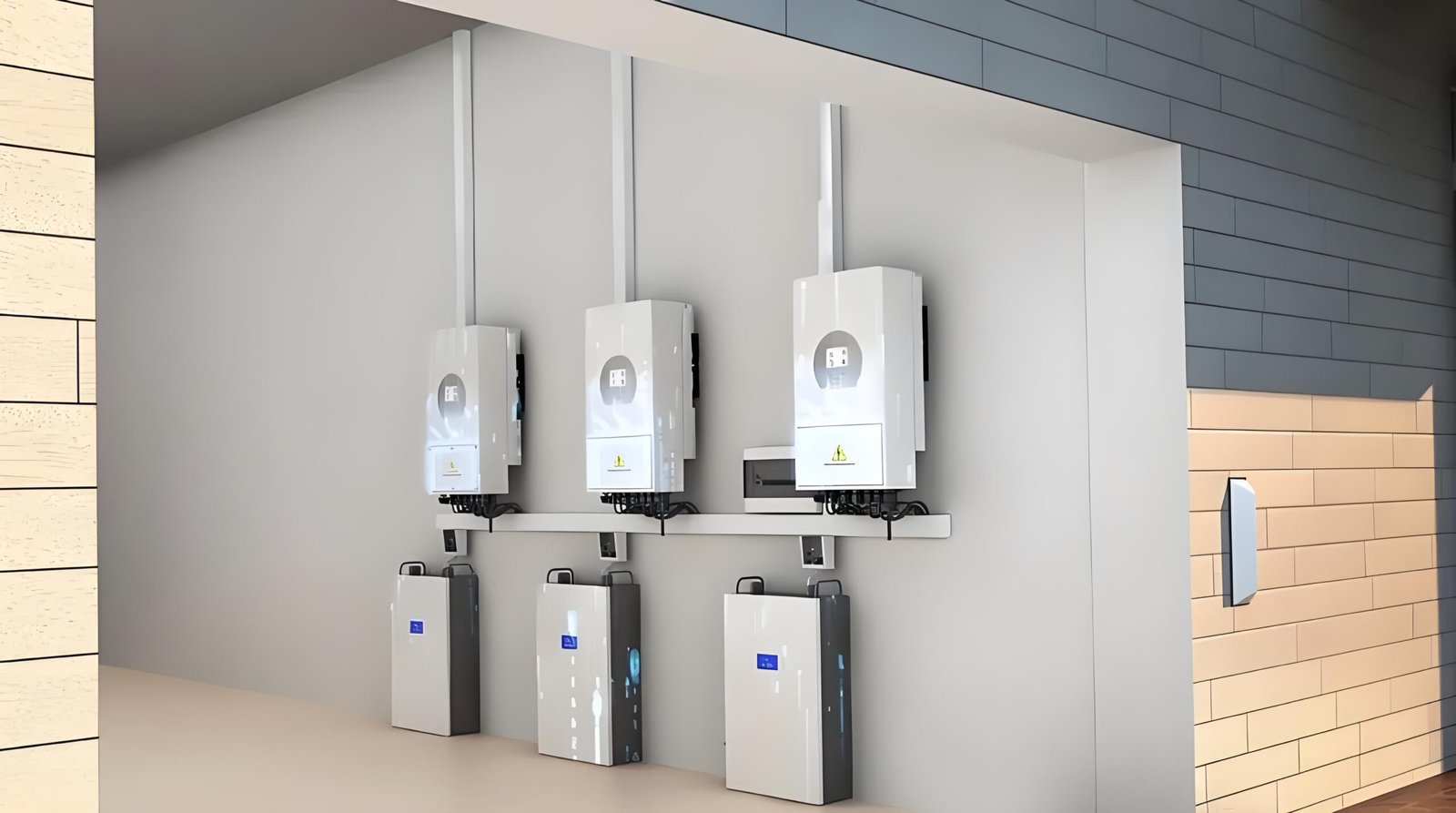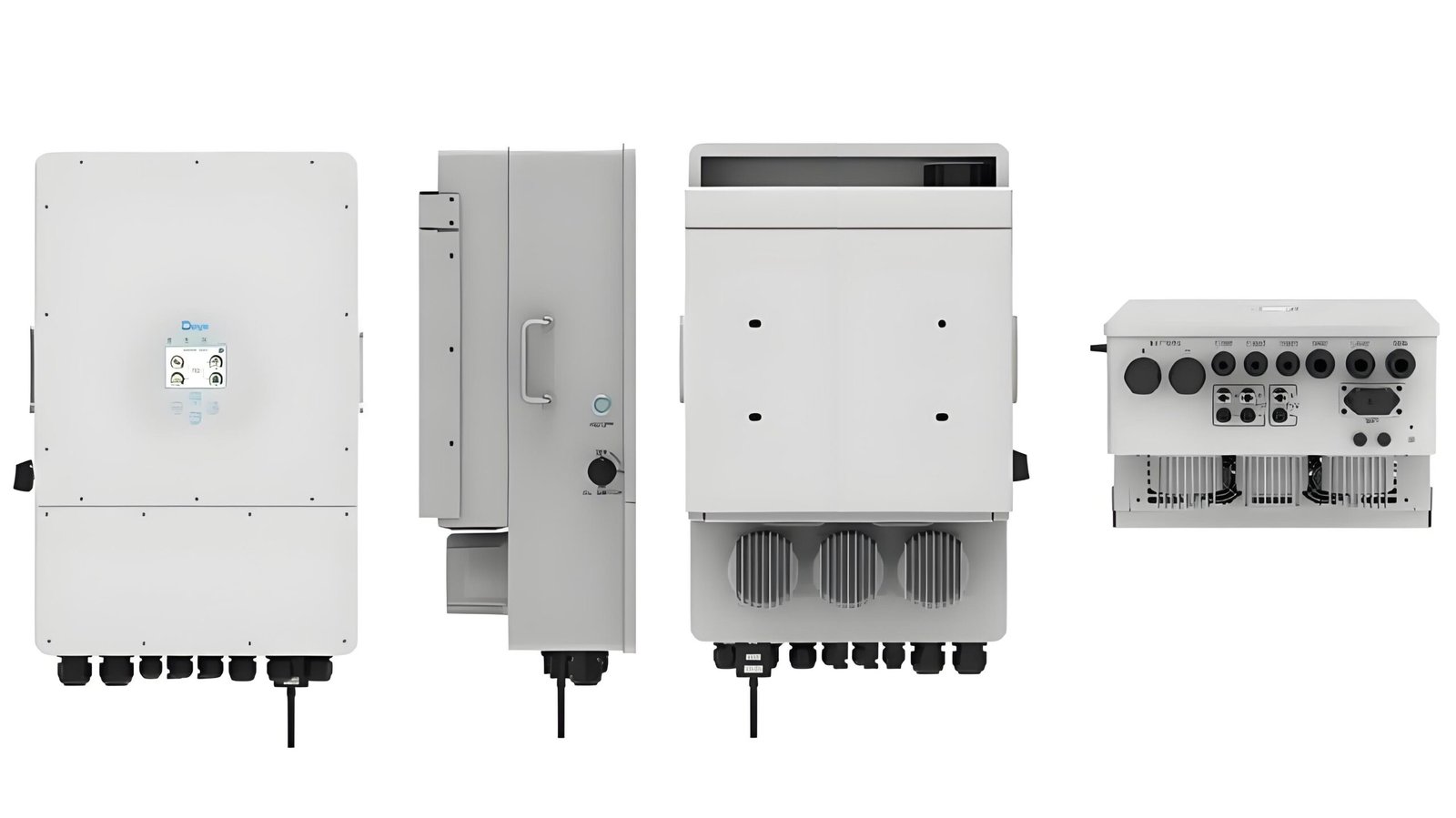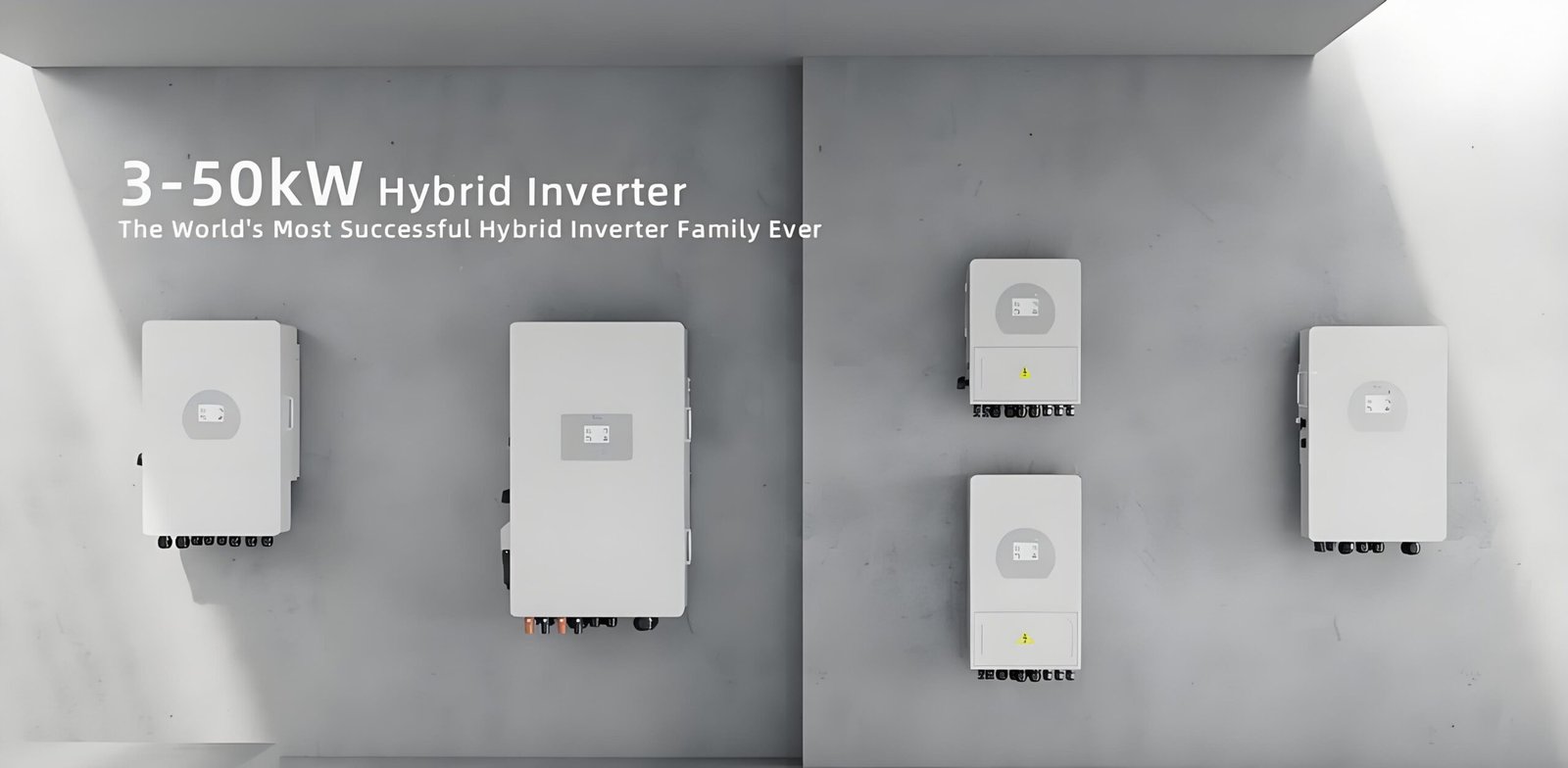The Deye Inverter SUN-5/6/8/10/12/15/20/25K-SG01HP3-EU-AM2 is a three-phase hybrid inverter designed to meet the needs of high-capacity solar energy systems. With features like advanced energy management, multi-operational modes, and extensive connectivity, it ensures reliable and efficient energy solutions for residential, commercial, and industrial setups.
Comprehensive Product Overview
This inverter combines the functionality of an inverter, solar charger, and battery charger, ensuring uninterrupted power and optimized energy usage.
Key Features:
- Three-Phase Output: Supports 230/400V systems for seamless integration.
- Multiple Operational Modes: Includes on-grid, off-grid, and UPS mode1.
- Dual MPPT Trackers: Maximizes energy harvest from multiple solar arrays.
- Battery Compatibility: Works with lithium-ion and lead-acid batteries.
- High Charging Capacity: Up to 350A for flexible battery configurations.
- Advanced Monitoring: Real-time data through WiFi or GPRS.
- Energy Management: Supports Time-of-Use settings for efficient energy allocation.
- [IP65 protection](What does IP65 protection mean?)2: Designed for outdoor installations.
Technical Specifications:
| Model | SUN-5K | SUN-6K | SUN-8K | SUN-10K | SUN-12K | SUN-15K | SUN-20K | SUN-25K |
|---|---|---|---|---|---|---|---|---|
| Rated Power Output | 5 kW | 6 kW | 8 kW | 10 kW | 12 kW | 15 kW | 20 kW | 25 kW |
| Max. PV Input Power | 10,000 W | 12,000 W | 16,000 W | 20,000 W | 24,000 W | 30,000 W | 40,000 W | 50,000 W |
| MPPT Voltage Range | 160–850V | 160–850V | 160–850V | 160–850V | 160–850V | 160–850V | 160–850V | 160–850V |
| Efficiency | 97.6% | 97.6% | 97.6% | 97.6% | 97.6% | 97.6% | 97.6% | 97.6% |
| Max. Charging Current | 150 A | 150 A | 200 A | 200 A | 250 A | 300 A | 300 A | 350 A |
Installation and Space Requirements
Correct installation is essential for optimal performance and safety.

Installation Environment:
- Placement: Mount on a stable vertical wall sheltered from direct sunlight, rain, and snow.
- Ventilation: Maintain a minimum clearance of 50 cm on all sides for heat dissipation. Ventilation requirements3.
- Operating Temperature: -40°C to +60°C (derating applies above 45°C).
- IP65 protection: IP65-rated for outdoor installations.
Mounting Instructions:
- Secure the mounting bracket to a load-bearing wall using expansion bolts.
- Hang the inverter on the bracket, ensuring it is level and securely attached.
- Verify stability before proceeding with electrical connections.
Battery and Grid Connection Guidelines
The SUN-5/6/8/10/12/15/20/25K-SG01HP3-EU-AM2 supports flexible battery setups and grid connections.
Battery Connection:
- Use the recommended cable sizes based on the model (refer to the table below).
- Ensure correct polarity and secure connections using a torque of 24.5 Nm. Torque requirements for battery connections4.
- Use a DC circuit breaker to ensure safety and compliance.
Recommended Cable Sizes:
| Model | Wire Size (AWG) | Cable Size (mm²) | Torque Value (Nm) |
|---|---|---|---|
| 5–10kW | 10 AWG | 6 mm² | 3.4 |
| 12–15kW | 8 AWG | 10 mm² | 3.4 |
| 20–25kW | 6 AWG | 16 mm² | 4.0 |
Grid and Load Connection:
- Install an AC breaker between the grid/load and the inverter for added protection. Role of AC breakers in solar systems5.
- Follow the wiring diagram provided in the manual to ensure proper polarity and secure connections.
Solar PV Integration and MPPT Optimization
This inverter’s dual MPPT trackers ensure maximum energy harvesting.

PV Module Requirements:
- Maximum PV Input Voltage: 1000V.
- MPPT Voltage Range: 160–850V.
- Maximum PV Input Power: Up to 50,000 W (for the 25kW model).
Recommended PV Parameters:
| Parameter | Value | Notes |
|---|---|---|
| Maximum Voc | 1000V | Do not exceed this limit |
| MPPT Voltage Range | 160–850V | Optimal efficiency range |
| Max Input Current (per MPPT) | 25A | Ensure panels match this limit |
Connection Steps:
- Turn off the DC isolator before connecting PV modules.
- Use approved connectors to secure PV strings to the MPPT inputs.
- Ensure proper sealing of connections to prevent electrical faults. Importance of sealing PV connections6.
Operational Modes and Monitoring
This hybrid inverter supports various operational modes and advanced monitoring options.

Operating Modes:
- On-Grid Mode: Uses solar and battery power first, then exports surplus energy to the grid.
- Off-Grid Mode: Supplies loads independently using solar and battery energy.
- UPS mode7: Ensures uninterrupted power during outages.
Monitoring and Connectivity:
- LCD Touchscreen: Provides real-time data, system status, and error codes.
- WiFi/GPRS connectivity8: Allows remote monitoring via the Deye app or cloud platform.
- Advanced Diagnostics: Tracks energy generation, consumption, and battery health.
Maintenance and Troubleshooting
Regular maintenance ensures reliable and efficient operation over the inverter’s lifespan.
Maintenance Tips:
- Inspect connections monthly for signs of wear or damage.
- Keep the inverter’s vents clear of dust and debris for proper cooling.
- Firmware updates9: Update firmware periodically to ensure compatibility with the latest features.
Troubleshooting Common Issues:
| Issue | Possible Cause | Solution |
|---|---|---|
| Inverter not powering on | Loose connections | Check and secure all wiring |
| Low energy efficiency | Dirty solar panels | Clean panels and optimize settings |
| Error Code: Overload | High connected load | Overload error troubleshooting10 |
| Error Code: Overtemperature | Poor ventilation | Improve airflow around the inverter |
Conclusion
The Deye Inverter SUN-5/6/8/10/12/15/20/25K-SG01HP3-EU-AM2 is a top-tier solution for high-capacity solar energy systems. With its robust features, advanced energy management, and high efficiency, it is the perfect choice for diverse applications. Optimize your energy system today with this versatile and reliable inverter.
Footnotes:
-
UPS mode ensures uninterrupted power by switching to battery backup during grid outages, providing reliability for critical applications. ↩
-
IP65 protection means the device is dust-tight and protected against water jets, making it ideal for outdoor use in harsh conditions. ↩
-
Proper ventilation prevents overheating and ensures the inverter operates within its optimal temperature range, increasing its efficiency and lifespan. ↩
-
Correct torque ensures secure battery connections, preventing overheating or damage caused by loose or overly tight connections. ↩
-
AC breakers provide overcurrent and short-circuit protection, ensuring the safety of the inverter and connected loads during faults. ↩
-
Proper sealing prevents water ingress, corrosion, and electrical faults, ensuring safe and reliable operation of the solar PV system. ↩
-
UPS mode ensures uninterrupted power by switching to battery backup during outages, protecting critical loads from power interruptions. ↩
-
WiFi and GPRS connectivity allow real-time remote monitoring and management of the inverter, improving system performance and diagnostics. ↩
-
Firmware updates ensure the inverter operates efficiently by fixing bugs, enhancing compatibility, and improving overall performance. ↩
-
Overload errors occur when the inverter is connected to loads exceeding its capacity. Reducing the load and restarting resolves the issue. ↩




